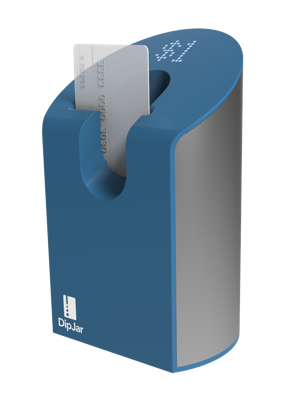This story originally appeared on Citylab.
Tipping can be a stressful process. As soon as you order at a coffee counter or get ready to pay at a restaurant, the same familiar questions rear their ugly heads: How much money should I leave? (Something concrete, like $1 a drink at a cafe, or at least 10 percent of whatever the total is?) Do I tip less for takeout and delivery? How good was the service, really?
It’s clear that some customers aren’t tipping enough, especially when we consider that low-wage workers rely on tips as part of their salary. Could interactive technology encourage us to fork over more money?
New tipping technology
Some customers don’t tip simply because they don’t have spare bills on hand, or spare change clanging around in their pockets. A new device aims to solve this issue by allowing people to tip using credit or debit cards. DipJar offers a convenient way for customers to show a little generosity: Just dip your card into the jar and remove it—the machine will deduct a preset amount ($1 in most locations). After the transaction goes through, the jar lights up and emits a sound effect to let people know a tip has been given.

DipJar CEO Ryder Kessler says customers prefer the device because they don’t have to opt out of tipping by pressing “zero” on a tablet or square reader. “The biggest barrier to generosity is decision-making friction,” he says. DipJar is designed to eliminate that barrier.
The psychology of tipping
But even when tipping is entirely voluntary, are customers really all that generous? To find out, I asked behavioral psychologist Dr. Jennifer Hartstein whether digital tipping actually makes a difference.
She informed me that, although tipping was originally created as a means of providing feedback and rewarding good service, “the expectation now is that we tip because there’s a tip jar in front of us.” This expectation “diminishes the meaning of the tip for people,” in turn creating “two very clear camps”—those for tipping, and those against it.
Digital tipping, Hartstein says, won’t change this much, although she admits that eliminating the stress typically associated with tipping might make people more inclined to leave a little something behind. As for the sound effect that DipJar makes once a tip has been given, Hartstein worries that “it has the risk of embarrassing people.”
Kessler disagrees, arguing that customers want to make sure the person behind the counter is aware of their generosity—something he jokingly refers to as the “Costanza effect.”
There’s also reason to believe that card holders are more inclined to give better tips. Research from psychologist Michael Lynn at Cornell University indicates that people who pay their restaurant bills with credit cards tend to tip more than those who pay cash. But there are other factors at play. Lynn’s research also shows that service workers receive greater tips when they do things like introduce themselves by name or write “Thank You” on the back of the check. Though service quality and tips are “weakly related,” Lynn found that smiling yields a 140 percent increase in tips.